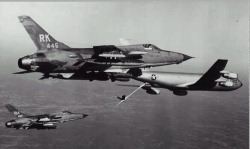| Col. Jack Broughton Interview by Leonard "Viking1" Hjalmarson | ||||
|
This time around you would be in the 105 series fighters. When was your first flight in the Thud and how many combat missions did you fly in that aircraft? JB: I checked out in the Thud at Yokota, Japan, right after I finished the National War College and left Washington. There were lots of similarities to previous Republic aircraft I had flown, so it didn't take long to get comfortable. I flew 102 combat missions in the F-105.
 I think you flew all the 100 series fighters. Which was your favorite and why? JB: I'd have to go with the C model. It was more advanced and smoother than the A, and did not have a lot of the stuff that was hung on later models. The C was great for the Thunderbirds in many ways, including being able to sneak up on the crowd from behind and open the show with a burner blast from just above their heads. You got their full attention immediately. More than a few pilots have chosen the 104 as their favorite of all time. What are your thoughts on that aircraft? JB: I was very fond of the F-104, and it certainly was a kick to fly. But if you asked me what I would like to have in the garage, if I could, I'd tell you to give me an F-106. Back to the war. If the politicians hadn't been in charge of the air war in Vietnam, how much difference would it have made? JB: If that war had been run properly, without the political foolishness, the entire thing could have ended with victory for us within a few months, and without killing some 58,000 Americans and untold hundreds of thousands of Vietnamese from both the North and South. The Joint Chief's list of 94 specific targets could have been easily and quickly eliminated by air power. I emphasize, I am not talking about bombing suspected enemy turnip gardens from 15,000 feet a la Kosovo, nor am I talking about defeating the entire North Vietnamese ground army. I am talking about going to war to win by quickly and completely obliterating Ho Chi Min's 94 virtually undefended symbols of national pride and progress. Believe me, the outcome would have been different. |
When you tell the story of the Turkestan incident you state that, "two things I had learned at the Point clashed head on: Don't ever get tangled up in the details of the regulations, and always take care of your people." It seems to be this statement epitomizes much of the tension between the policy makers and actual pilots in the air war in Vietnam. Do you think it is possible to fight a war where this tension doesn't exist? JB: The conflict you mention is a direct reflection of national leadership. When we went into the Gulf War, our leaders paid attention to lessons learned in Southeast Asia, and things went generally well. Our leadership has since forgotten lessons learned, and frighteningly, our military machinery is a mess. If American leadership continues to consider the military a fun thing with which to play make believe, don't win war, a good relationship can not exist. If national leadership went back to considering military involvement to be a last resort as a result of political failure, we would be on a better course. If America again had properly manned and equipped forces, and if national leadership ordered military leaders to lead those forces to victory on the fields of battle, there would be no conflict. The final three chapters of the book tell the story of the attempt by General Ryan to have you court martialed. It's an incredible story of how "the system" can fail and like a cancer, turn on its own. While you ended your career with a clean record, it was a sad time for the Air Force and for you personally. Do you ever wish you had chosen to stay in the service beyond 1968? JB: No. I had given my country absolutely everything I had since I was seventeen years old. I had a fascinating military career, and I have the fondest memories of the good people, equipment and places involved in that career. My own Air Force fought me because of my two-way loyalty; loyalty to mission accomplishment, and loyalty to those I led in combat. That convinced me that I loved the Air Force more than the Air Force loved me, and it was time for my family and I to move on to bigger and better things. Going Downtown is an important story. Thanks for telling it and thanks for taking the time for this interview! Related Links Join a discussion forum on this article by clicking HERE.
|
|||
|
Copyright © 1997 - 2000 COMBATSIM.COM, INC. All Rights Reserved. Last Updated December 22nd, 1999 |
||||
